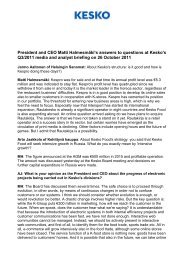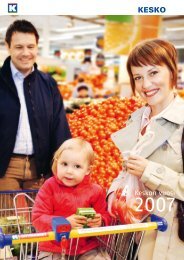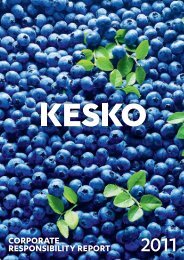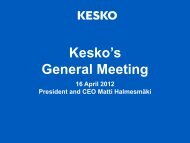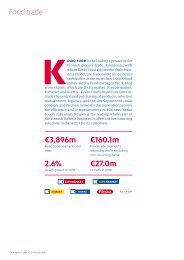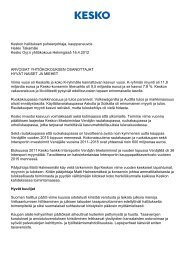Create successful ePaper yourself
Turn your PDF publications into a flip-book with our unique Google optimized e-Paper software.
88 <strong>Kesko's</strong> <strong>year</strong> <strong>2007</strong><br />
Goodwill and other intangible assets<br />
Goodwill represents the excess of the Group's share of the fair value of<br />
the acquiree's net assets at the date of the acquisition. The goodwill of<br />
companies acquired prior to 1 January 2004 corresponds to their carrying<br />
amounts reported in accordance with the previous accounting practices,<br />
and the carrying amount is used as the deemed cost. The classification<br />
and accounting treatment of business combinations entered into<br />
prior to 1 January 2004 were not adjusted in preparing the consolidated<br />
IFRS opening balance sheet.<br />
Goodwill is not amortised but tested annually for impairment and<br />
whenever there is an indication of impairment. For impairment testing<br />
purposes goodwill is allocated to the cash generating units. Goodwill is<br />
measured at original cost and the share acquired prior to 1 January 2004<br />
at deemed cost net of impairment. Any negative goodwill is immediately<br />
recognised as income in accordance with IFRS 3.<br />
Intangible assets with indefinite useful lives are not amortised. They<br />
are tested for impairment annually and whenever there is an indication<br />
of impairment. These intangible assets include trademarks capitalised<br />
upon acquisition. The costs of intangible rights with definite useful lives<br />
are stated in the balance sheet and recognised as expenses during their<br />
useful lives. Such intangible assets include software licences and customer<br />
relationships to which acquisition cost has been allocated upon<br />
acquisition. The estimated useful lives are:<br />
Computer software and licences 3–5 <strong>year</strong>s<br />
Customer and supplier relationships 10 <strong>year</strong>s<br />
Research and development<br />
The cost of research and development activities is recognised as an<br />
expense in the income statement. The Group has not had such development<br />
expenses which, under certain conditions, should be recognised as<br />
assets and written off during their useful lives in accordance with IAS 38.<br />
Computer software<br />
The labour costs and other direct expenditure of persons employed by the<br />
Group, working on development projects related to the acquisition of new<br />
computer software, are capitalised as part of the software cost. In the balance<br />
sheet, computer software is included in intangible assets and its<br />
cost is written off during the useful life of the software. Software maintenance<br />
expenditure is recognised as an expense when incurred.<br />
Tangible assets<br />
Tangible assets mainly comprise land, buildings, machinery and equipment.<br />
Tangible assets are carried at original cost net of planned depreciation<br />
and any impairment. The tangible assets of acquired subsidiaries<br />
are measured at fair value at the date of acquisition.<br />
The machinery and equipment of buildings are treated as separate<br />
assets and any significant expenditure related to their replacement is<br />
capitalised. Subsequent expenditure relating to a fixed asset is only<br />
added to the carrying amount of the asset when it is probable that future<br />
economic benefits relating to the asset will flow to the Group and that<br />
the cost of the asset can be reliably measured. The repair, service and<br />
maintenance expenditure of other tangible assets is recognised as an<br />
expense when incurred.<br />
Tangible assets are written off on a straight-line basis during their<br />
estimated useful lives.<br />
The most common estimated useful lives are:<br />
Buildings 10–40 <strong>year</strong>s<br />
Components of buildings 8–10 <strong>year</strong>s<br />
Machinery and equipment 3–8 <strong>year</strong>s<br />
Cars and transport equipment 5 <strong>year</strong>s<br />
The residual values, useful lives and depreciation methods applied to<br />
tangible assets are reviewed at least at the end of each accounting period.<br />
If the estimates of useful life and the expected pattern of economic benefits<br />
are different from previous estimates, the change in the estimate is<br />
accounted for in accordance with IAS 8.<br />
The depreciation of a tangible asset ceases when the asset is classified<br />
as held for sale in accordance with IFRS 5. Land is not depreciated.<br />
Gains and losses from sales and disposals of tangible assets are recognised<br />
in the income statement and presented as other operating<br />
income and expenses.<br />
Investment properties<br />
Investment properties are properties held by the enterprise mainly to<br />
earn rentals or for capital appreciation. The Group does not hold real<br />
estate classified as investment properties.<br />
Impairment<br />
At each reporting date, the Group assesses whether there is any indication<br />
that an asset may be impaired. If any such indication exists, the<br />
recoverable amount of the asset is estimated. The recoverable amount of<br />
goodwill and intangible assets with indefinite useful lives is assessed<br />
every <strong>year</strong> whether or not there is an indication of impairment. In addition,<br />
an impairment test is performed whenever there is an indication of<br />
impairment.<br />
The recoverable amount is the higher of an asset's net selling price<br />
less the costs of disposal, and its value in use. Often it is not possible to<br />
assess the recoverable amount for an individual asset. Then, as in the<br />
case of goodwill, the recoverable amount is determined for the cash generating<br />
unit to which the goodwill or asset belongs. The recoverable<br />
amount of available-for-sale financial assets is the fair value based on<br />
either the market price or the present value of cash flows.<br />
An impairment loss is recognised if the carrying amount of an asset<br />
exceeds its recoverable amount. The impairment loss is disclosed in the<br />
income statement. An impairment loss recognised for an asset in prior<br />
<strong>year</strong>s is reversed if there has been an increase in the reassessed recoverable<br />
amount. The reversal of an impairment loss of an asset should not<br />
exceed the carrying amount of the asset without an impairment loss recognition.<br />
For goodwill, a recognised impairment loss is not reversed<br />
under any circumstances.<br />
Leases<br />
In accordance with IAS 17, leases that substantially transfer all the risks<br />
and rewards incident to ownership to the Group are classified as finance<br />
leases. An asset leased under a finance lease is recognised in the balance<br />
sheet at the lower of its fair value at the inception date and the present<br />
value of minimum lease payments. The rental obligations of finance<br />
leases are recorded in interest-bearing liabilities in the balance sheet.<br />
Lease payments are allocated between interest expense and reduction of<br />
the lease liability. Finance lease assets are amortised over the shorter<br />
period of the useful life and the lease term.




